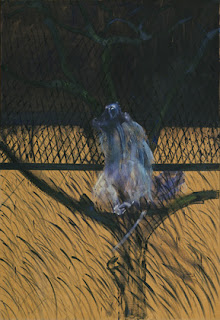Upon a
recent trip to the MoMA, I took the role of a curator and attempted to put
together an exhibition based on animals from all over the world, since the
artwork I would be using was from artists all over the world. I used artworks
from different departments of the museum, such as the Media and Performance
department, the Prints and Illustrated Books department, the Painting and
Sculpture department, and also the Drawing department.
The
first piece that I came across that captured my attention was
"She-Goat" by Pablo Picasso from the Painting and Sculpture
department. This specific piece caught my attention because of the dark-colored
bronze it was made of. I feel the bronze of this piece helps depict some of the
details such as the protruding udders of the goat that also help define the
femininity of the piece. Being the first piece that captured my attention, it
also gave me an idea of what to look for specifically in the rest of the
pieces I would include in my6
exhibition. This piece helped me decide that I would use not only animals as we
humans see them, but also as they are seen through artist's perspective.
"Baboon
Bride" by Chris Finley is another excellent example of seeing an animal
through an artist's perspective. This work of art, part of the Drawing
department of the museum, gives a great, almost humorous tone. The whaling
baboon in the wedding dress immediately makes me think of women who become
beast-like during the planning of their weddings. The way the gowned baboon is
sitting in this drawing also immediately makes me think that it is in the
middle of a very loud tantrum. It makes me wonder if Finley's intentions were
to spark up thoughts much like mine. To me, it is a brilliant piece and I would
definitely use this piece.
On a
more realistic note however, the film "Cat" by Roman Signer from the
Media and Performance Art department, I feel would also be a great addition to
the collection I was putting together. This is because I feel by creating a tie
between realistic artworks and those from the imaginations of artists, we can
really learn to appreciate the beauty of the animals around us, whether they be
household pets or animals from exotic lands. The film, which is nothing out of
the ordinary, really fits in with the other realistic pieces I have chosen.
As
mentioned before, the tie between both realistic and surreal pieces for my
collection really helps enhance the beauty of the nature in the animals of each
piece. They also help highlight the similarities between humans and animals, creating
a mental bond that really gets your gears working. The overall experience of
becoming a curator, actually made me consider it as a career choice. I wouldn't
mind choosing pieces that would really get into the minds of audiences around
me for a living.
Finley, Chris. "Baboon Bride" 1953. Drawings.
Broodthaers, Marcel. "Belgian Lion" 1968. Paintings and Sculptures.
Buchanan, Nancy. "California Stories" 1983. Media and Performance
Goben, Robert. "Cat Litter" 1989. Paintings and Sculpture.
Signer, Roman. "Cat" 1979. Media and Performace
Kahlo, Frida. "Fulang-Chang and I" 1937. Paintings and Sculptures.
Chagall, Marc. "I and the Village" 1968 Paintings and Sculpture
Viola, Bill. "I Do Not Know What it is I am Like" 1986. Media and Performance
Mino, Joan. "Object" 1936. Painting and Sculpture
Broodthaers, Marcel. "Pot of Mussels" 1968. Paintings and Sculpture
Picasso, Pablo. "She-Goat" 1950. Paintings and Sculpture
Gauguin, Paul. "Still Life with Three Puppies" 1888. Paintings and Sculpture
Bacon, Francis. "Sudy of a Baboon" 1953. Paintings and Sculpture
Liam, Wilfredo. "The Jungle" 1943. Drawings
Chapman, Jake. "Untitled from Exquisite Corpse" 2000. Prints and Illustrated Books.















